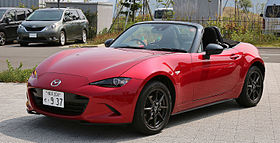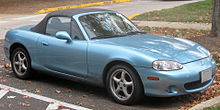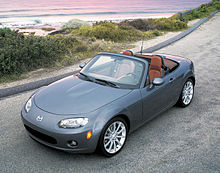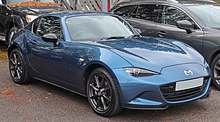Mazda MX-5
| Mazda MX-5 | |
|---|---|
 | |
| Overview | |
| Manufacturer | Mazda |
| Also called | Mazda MX-5 Miata (U.S.) Mazda Miata (U.S.) Eunos Roadster (Japan) Mazda Roadster (Japan) |
| Production | 1989–present |
| Assembly | Japan: Hiroshima (Hiroshima Plant) |
| Body and chassis | |
| Class | Roadster, sports car (S) |
| Layout | Front mid-engine, rear-wheel-drive |
| Platform | Mazda N platform |
The Mazda MX-5 is a lightweight two-passenger roadster manufactured and marketed by Mazda with a front mid-engine, rear-wheel-drive layout. The convertible is marketed as the Mazda MX-5 Miata /miˈɑːtə/ in North America, where it is widely known as the Miata, and as the Eunos Roadster (ユーノス・ロードスター Yūnosu Rōdosutā) or Mazda Roadster (マツダ・ロードスター Matsuda Rōdosutā) in Japan.
Manufactured at Mazda's Hiroshima plant, the MX-5 debuted in 1989 at the Chicago Auto Show and was conceived and executed under a tightly focused design credo, Jinba ittai (人馬一体), meaning oneness of horse and rider. Widely noted for its small, light, technologically modern, dynamically balanced and minimally complex design, the MX-5 is the spiritual successor to 1950s and '60s Italian and British sports cars, prominently the Lotus Elan.
Generations were internally designated with a two letter code, beginning with the first generation, the NA. The second generation, (NB), launched in 1998 for MY 1999; followed by the third generation (NC) in 2005 for MY 2006, and the fourth generation (ND) in 2015 for MY 2016 (along with "ND2" being the designation for MY 2019).
As the best-selling two-seat convertible sports car in history,[1] the MX-5 has been marketed globally, with production exceeding one million, as of early 2016.[2] The name "miata" derives from Old High German for "reward".[3]
Contents
Generations and overview[edit]
The MX-5's first generation, the NA, sold over 400,000 units from May 1989 to 1997—with a 1.6 L (98 cu in) inline-four engine to 1993, a 1.8 L (110 cu in) engine thereafter (with a de-tuned 1.6 as a budget option in some markets)—recognizable by its pop-up headlights. The second generation (NB) was introduced in 1999 with a slight increase in engine power; it can be recognized by the fixed headlights and the glass rear window, although first generation owners may opt for the glass window design when replacing the original top. The third generation (NC) was introduced in 2006 with a 2.0 L (120 cu in) engine and slightly larger body size, with a Power Retractable Hard Top variant added in 2007. The fourth generation (ND) was introduced in 2015 with a new 2.0 L (120 cu in) SKYACTIV-G engine and a body size similar to the first generation model, with a Retractable Fastback (RF) variant added later that year.
Launched at a time when production of small roadsters had almost come to an end, the Alfa Romeo Spider was the only comparable volume model in production at the time of the MX-5's launch. Just a decade earlier, a host of similar models—notably the MG B, Triumph TR7, Triumph Spitfire, and Fiat Spider—had been available.
The body is a conventional, but light, unibody construction, with (detachable) front and rear subframes. The MX-5 also incorporates a longitudinal truss, marketed as the Powerplant Frame (PPF), providing a rigid connection between the engine and differential, minimizing flex and contributing to responsive handling. Some MX-5s feature limited slip differentials and anti-lock braking system. Traction control is an option on NC models and standard on ND models. MX-5s weigh slightly over one tonne.
With an approximate 50:50 front/rear weight balance, the car has nearly neutral handling. Inducing oversteer is easy and very controllable, thus making the MX-5 a popular choice for amateur and stock racing,[4] including, in the US, the Sports Car Club of America's Solo autocross and Spec Miata race series, and in the UK, the 5Club Racing championship. Raddatz and Otten won the AASA Australian Endurance Championship in 2011.
The MX-5 has won awards including Wheels Magazine 's Car of the Year for 1989, 2005 and 2016;[5] Sports Car International's "best sports car of the 1990s" and "ten best sports cars of all time"; 2005–2006 Car of the Year Japan; and 2005 Australian Car of the Year. The Miata has also made Car and Driver magazine's annual 10 Best list 17 times.[6] In their December 2009 issue, Grassroots Motorsports magazine named the Miata as the most important sports car built during the previous 25 years.
In 2009, English automotive critic Jeremy Clarkson wrote:
The fact is that if you want a sports car, the MX-5 is perfect. Nothing on the road will give you better value. Nothing will give you so much fun. The only reason I’m giving it five stars is because I can’t give it fourteen.[7]
Design genesis[edit]
In 1976, Bob Hall, a journalist at Motor Trend magazine who was an expert in Japanese cars and fluent in the language, met Kenichi Yamamoto and Gai Arai, head of Research and Development at Mazda. Yamamoto and Gai Arai asked Hall what kind of car Mazda should make in the future:[8]
I babbled [...] how the [...] simple, bugs-in-the-teeth, wind-in-the-hair, classically-British sports car doesn't exist any more. I told Mr. Yamamoto that somebody should build one [...] inexpensive roadster.[9]
In 1981, Hall moved to a product planning position with Mazda USA and again met Yamamoto, now chairman of Mazda Motors, who remembered their conversation about a roadster and in 1982 gave Hall the go-ahead to research the idea further.[8] At this time Hall hired designer Mark Jordan to join the newly formed Mazda design studio in Southern California. There, Hall and Jordan collaborated on the parameters of the initial image, proportion and visualization of the "light-weight sports" concept. In 1983, the idea turned concept was approved under the "Offline 55" program, an internal Mazda initiative that sought to change the way new models were developed. Thus, under head of project Masakatsu, the concept development was turned into a competition between the Mazda design teams in Tokyo and California.[8]
The Californian team proposed a front-engine, rear-wheel-drive layout, codenamed Duo 101, in line with the British roadster ancestry, but their Japanese counterparts favored the more common front-engine, front-wheel-drive layout or the rear mid-engine, rear-wheel-drive layout.[10]
The first round of judging the competing designs was held in April 1984, with designs presented on paper only. The mid-engined car appeared to offer favorable qualities, although it was known at the time that such a layout would struggle to meet the noise, vibration, and harshness (NVH) requirements of the project. It was only at the second round of the competition in August 1984, when full-scale clay models were presented, that the Duo 101 won the competition and was selected as the basis for what would become the MX-5.
The Duo 101, so named as either a soft top or hardtop could be used, incorporated many key stylistic cues inspired by the Lotus Elan, a 1960s roadster, including the door handles and grille opening. International Automotive Design (IAD) in Worthing, England was commissioned to develop a running prototype, codenamed V705. It was built with a fiberglass body, a 1.4 L (85 cu in) engine from a Mazda Familia and components from a variety of early Mazda models. The V705 was completed in August 1985 and taken to the US where it rolled on the roads around Santa Barbara, California and got positive reactions.
The project received final approval on 18 January 1986.[8] The model's codename was changed to P729 as it moved into the production phase, under head of program Toshihiko Hirai. The task of constructing five engineering mules (more developed prototypes) was again allocated to IAD, which also conducted the first front and rear crash tests on the P729. While Tom Matano,[11] Mark Jordan, Wu Huang Chin, Norman Garrett, and Koichi Hayashi worked on the final design, the project was moved to Japan for engineering and production details.
By 1989, with a definitive model name now chosen, the MX-5 was ready to be introduced to the world as a true lightweight sports car, weighing just 940 kg (2,070 lb).
Although Mazda's concept was for the MX-5 to be an inexpensive sports car, at introduction the design met strong demand, with many dealers placing customers on pre-order lists and several dealers across North America increasing the vehicle markup.[citation needed]
Jinba ittai[edit]
Mazda used a design credo across the four generations of the MX-5's development: the phrase Jinba ittai (人馬一体, [dʑimba ittai]),[12] which translates loosely into English as "rider (jin) and horse (ba) as one body (ittai)".
With the first generation of the MX-5, the phrase was developed into five specific core design requirements:
- That the car would be as compact and as light as possible while meeting global safety requirements.
- That the cockpit would comfortably accommodate two full-stature occupants with no wasted space.
- That the basic layout would continue with the original's front-midship rear-drive configuration with the engine positioned ahead of the driver but behind the front axle for 50:50 weight distribution.
- That all four wheels would be attached by wishbone or multi-link suspension systems to maximize tire performance, road grip, and dynamic stability.
- And that a power-plant frame would again provide a solid connection between the engine and rear-mounted differential to sharpen throttle response.
First generation (NA)[edit]
The first generation MX-5 was introduced in 1989 and was in production until 1997. Upon its release, the car won numerous accolades such as Automobile Magazine's 1990 Automobile of the Year and Car and Driver's 10Best list from 1990 to 1992.
Second generation (NB)[edit]
The second generation MX-5 was unveiled in 1997 and put on sale in 1998 for the 1999 model year. While it kept the same proportions of its predecessor, its most noticeable change was the deletion of the retractable headlamps, which no longer passed pedestrian safety tests and were replaced by fixed ones.
Third generation (NC)[edit]
Taking design cues from the 2003 Mazda Ibuki concept car, the third generation Mazda MX-5 was introduced in 2005 and was in production until 2015. This generation introduced a Power Retractable Hard Top variant that features a folding mechanism that does not interfere with trunk space. During its release, the third generation MX-5 received several accolades such as the 2005-2006 Car of the Year Japan Award and Car and Driver's 10Best list from 2006 to 2013.
Fourth generation (ND)[edit]
The fourth generation Mazda MX-5 was unveiled in 2014 and has been in production from 2015 through 2018. Although the update introduced in 2018 is basically the same, it has been designated as series "ND2" due to the engine upgrade to 135 kW (181 hp) and several other improvements in the car. The ND generation introduced a Retractable Fastback (RF) variant that features a rigid roof and buttresses that give the silhouette a more coupé-like appearance than the soft top convertible. The fourth generation MX-5 has received several accolades such as the 2015-2016 Car of the Year Japan Award, the 2016 World Car of the Year Award, Car and Driver's 10Best list from 2016 to 2019, and the Red Dot Best of the Best Award in Product Design 2017. In addition, the car is the basis for the Fiat 124 Spider and Abarth 124 Spider.
Production numbers and details[edit]
In 2000, the Guinness Book of World Records declared the MX-5 the best-selling two-seat sports car in history, with a total production of 531,890 units.[13] The 250,000th MX-5 rolled out of the factory on November 9, 1992; the 500,000th, on February 8, 1999; the 750,000th, in March 2004; the 800,000th in January 2007, and the 900,000th in February 2011.[1][14]
On April 22, 2016, Mazda broke its Guinness World Record by producing its one millionth MX-5.[2] The one millionth car rolled off the production line and was shown in select cities, where the first 240 fans of the vehicle present could physically sign it before it went to the next destination.[15]
| showCalendar year |
Production | Sales (U.S.) | Sales (Canada) |
Sales (Australia) |
Sales (UK) |
Sales (Europe) |
Sales (Japan) |
Sales (Others) |
Sales (Global) | Model |
|---|
Awards and recognition[edit]
- Automobile Magazine 1990 "Automobile of the Year"[20] and "All-Stars" list in 2016.[21]
- Car and Driver's 10Best list from 1990-1992, 1998-1999, 2001, 2006-2013, 2016-2019.[22][23]
- Car of the Year Japan Award 2005-2006 and 2015-2016.[24]
- 2006 World Car of the Year Awards: "World Car of the Year" Finalist.[25]
- 2012 Autocar Indonesia Reader's Choice Award, Favorite Convertible.[26]
- What Car? Magazine 2014 Used Car of the Year - Best Fun Car.[27]
- Yahoo! Autos 2016 Fresh Ride of the Year.[28]
- Roadshow by CNET Editors Choice Best Convertibles 2016.[29]
- World Car of the Year at the 2016 World Car Awards (UK).[30]
- 2016 World Car of the Year Awards: "World Car of the Year" and "World Car Design of the Year".[31]
- 2016 UK Car of the Year.[32]
- The Daily Telegraph 2016 Car of the Year.[33]
- Auto Express 2017 Roadster of the Year.[34]
- Red Dot Best of the Best Award: Product Design 2017.[35]
- New York Daily News DNA Award 2018.[36]
- What Car? Magazine 2018 Best Convertible Less Than £25,000.[37]
- MotorWeek Drivers' Choice Awards Best Convertible 2018.[38]
- 2018 RJC Car of the Year Special Award: Classic Car Restoration Service.[39]
- Edmunds.com 2019 Editor's Choice Awards: Best Sports Car.[40]
- iSeeCars named the Mazda MX-5 Miata as the top sports car that owners keep the longest. [41]
See also[edit]
- Spec Miata, a class of racing cars in the U.S.
- Global MX-5 Cup, a Spec Miata series sanctioned by IndyCar
- MaX5 Racing, a class of racing cars in the United Kingdom
References[edit]
- ^ Jump up to: a b "900,000th Mazda MX-5 to Set New Guinness World Record". Mazda.com. 2011-02-04. Retrieved 2012-10-07.
- ^ Jump up to: a b "Mazda builds 1 millionth MX-5" (Press release). Autoblog. 2016-04-25. Retrieved 2016-04-25.
- ^ "The Meaning of Miata". Miata.net. Retrieved 2009-05-09.
- ^ Manjoo, Farhad (March 27, 2015). "In Silicon Valley, Auto Racing Becomes a Favorite Hobby for Tech Elites". The New York Times. Retrieved March 27, 2015.
the most popular car for racing enthusiasts is a Mazda Miata, older models of which sell for less than $5,000.
- ^ Ponchard, Nathan (2016-01-21). "2016 Wheels Car of the Year winner: Mazda MX-5". Wheels Magazine. Australia. Retrieved 2017-02-11.
- ^ "Awards & Reviews". Mazda. Retrieved 2018-10-03.
- ^ Clarkson, Jeremy (2009-08-16). "Mazda MX-5 2.0i Sport Tech". Retrieved 2014-12-27.
- ^ Jump up to: a b c d You and Your MX5/Miata, Liz Turner 2002, Haynes Publishing, ISBN 1-85960-847-7.
- ^ "Ikigai Man: Bob Hall and the Original Mazda Miata – Details on the history of Bob Hall's influence on the design, development and manufacture of the MX-5". Automobilemag.com. 2005-01-23. Retrieved 2014-12-27.
- ^ Torchinsky, Jason (2014-09-04). "The Miata Could Have Been Mid-Engined Or Even FWD". Jalopnik. US. Retrieved 2017-05-14.
- ^ "Mazda MX-5 MkIII". Independent.co.uk. 2006-04-23. Retrieved 2011-06-02.
- ^ "Jinba Ittai - The Oneness of Horse and Rider". USA: Mazda. Retrieved 2016-12-22.
- ^ Garlitos, Kirby (2011-04-02). "Mazda MX-5 Miata breaks Guinness World Record with 900,000th car". Topspeed.
- ^ "Mazda MX-5 production passes 900,000". Autoexpress.co.uk. 2011-02-04. Retrieved 2011-06-02.
- ^ Joseph, Noah (2016-04-25). "Mazda builds 1 millionth MX-5". Autoblog. Retrieved 2018-06-26.
- ^ Jump up to: a b "Mazda MX-5 UK Sales Pass 100,000 Milestone". Motorward.com. 2010-09-02. Retrieved 2012-10-07.
- ^ "Rover takes the lead in open-top revival". Independent.co.uk. 1997-03-03. Retrieved 2012-11-09.
- ^ Jump up to: a b c d e f g h i j k l m n o p q r s t u v w x y z "Mazda MX-5 Miata Sales Figures". Goodcarbadcar.net. Retrieved 2016-01-06.
- ^ "SMMT published Motor Industry Facts Figures". Smmt.co.uk. Retrieved 2015-11-11.
- ^ Jennings, Jean (2013-11-18). "First Time's the AOY Charm: 1990 Mazda Miata | Automobile Magazine". Automobile Magazine. US. Retrieved 2017-03-14.
- ^ St. Antoine, Arthur (2016-03-22). "2016 Automobile All-Stars: The Winners". Automobile. Retrieved 2019-01-19.
- ^ "Mazda MX-5 Miata - 10Best Cars". Car and Driver. Retrieved 2018-05-27.
- ^ "2019 10Best Cars". Car and Driver. 2018-11-29. Retrieved 2018-11-30.
- ^ "Japan Car of the Year Award". BATFA Japan. Retrieved 2018-05-27.
- ^ "BMW 3 Series crowned 2006 World Car of the Year". Autoweek. 2006-04-13. Retrieved 2018-10-03.
- ^ "Awards". Mazda. Retrieved 2018-10-07.
- ^ "Used Mazda MX-5 wins 'fun car' category at What Car? awards". Mazda. 2014-09-16. Retrieved 2018-10-03.
- ^ "2016 Yahoo Autos Fresh Ride of the Year: Mazda MX-5 Miata". Yahoo.com. Retrieved 2015-11-17.
- ^ "2016 Mazda MX-5 Miata review - Roadshow". CNET. 2015-07-28. Retrieved 2016-02-22.
- ^ Simpson, John (2016-03-24). "Mazda MX-5 named World Car of the Year 2016, ahead of A4 and Merc's GLC". Contract Hire And Leasing. UK. Retrieved 2016-03-31.
- ^ "Mazda MX-5 wins 2016 World Car of the Year award". The Japan Times. 2016-03-25. Retrieved 2018-10-03.
- ^ Simpson, John (2016-03-02). "Mazda MX-5 named UK Car of the Year 2016". Contract Hire And Leasing. UK. Retrieved 2016-03-31.
- ^ Hudson, Paul (2016-07-08). "Mazda MX-5 named Telegraph Car of the Year 2016". The Daily Telegraph. Retrieved 2018-10-03.
- ^ "Roadster of the Year 2017: Mazda MX-5 RF". Auto Express. 2017-06-28. Retrieved 2018-05-28.
- ^ "Red Dot Award: Product Design - Mazda MX-5 RF". Red Dot. Retrieved 2018-05-28.
- ^ Hunting, Benjamin (2018-03-21). "DNA Award Winner: 2018 Mazda MX-5 Miata". New York Daily News. Retrieved 2018-05-28.
- ^ "What Car? Car of the Year Awards 2018: Mazda MX-5 2.0 SE-L". What Car?. Retrieved 2018-05-28.
- ^ "MotorWeek Drivers' Choice Awards". MotorWeek. 2018-02-08. Retrieved 2018-06-01.
- ^ "第27回(2018年次)RJC カー オブ ザ イヤー". Automotive Researchers' and Journalists' Conference of Japan. Retrieved 2018-10-03.
- ^ "2019 Editor's Choice Awards". Edmunds.com. 2019-02-12. Retrieved 2019-02-12.
- ^ Blackley, Julie. "Cars Original Owners Keep for 15 Years or Longer". iSeeCars. Retrieved February 14, 2019.
Bibliography[edit]
- Long, B. MX-5 Miata – The full story of the world's favourite sports car, Veloce Publishing, 2002. ISBN 1-903706-21-1.
- Carey, J. (March, 2005). "New Mazda MX-5". Wheels (Australia), p. 48.
External links[edit]
| Wikimedia Commons has media related to |
- Official website
- Official website (The Story of the MX-5)
- Mazda MX-5 Miata at Curlie
| show |
|---|
| show « previous — Mazda road car timeline, 1990s–present
|
|---|
| show Mazda automobile timeline, North American market, 1980s–present
|
|---|

.svg.png)



